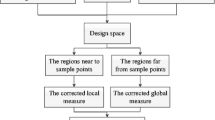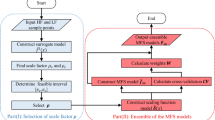Abstract
Due to the advantages of easy implementation and high efficiency, surrogate models have been widely used in designing complex engineering systems. In general, a stand-alone surrogate model cannot perform well for all engineering design problems, and the performance of a surrogate model is not known in advance. Ensembles of surrogates that combine various stand-alone surrogates have been developed to improve the robustness of stand-alone surrogate models. Inspired by the previous research on using the heuristic formulation to calculate weights of stand-alone surrogate models, we propose a pointwise ensemble of surrogates with adaptive function and heuristic formulation (PEAH) in this paper. The adaptive function presented in this paper contains the local accuracy and prediction uncertainty information around a prediction point. Thus, the adaptive function can adapt to the local characteristics of the prediction point. Various analytical test functions and two engineering design problems have been selected to test PEAH, and existing well-known ensembles of surrogates are employed to compare with the proposed pointwise ensemble model. The test results indicate that PEAH performs better in those problems with a better balance between accuracy and robustness.











Similar content being viewed by others
References
Acar E (2010) Various approaches for constructing an ensemble of metamodels using local measures. Struct Multidisc Optim 42(6):879–896
Acar E, Rais-Rohani M (2009) Ensemble of metamodels with optimized weight factors. Struct Multidisc Optim 37(3):279–294
Bishop CM et al (1995) Neural networks for pattern recognition. Oxford University Press, Oxford
Box GE, Hunter WH, Hunter S et al (1978) Statistics for experimenters: an introduction to design, data analysis and model building, vol 664. Wiley, New York
Carpenter W, Barthelemy JF (1993) A comparison of polynomial approximations and artificial neural nets as response surfaces. Struct Optim 5(3):166–174
Chen H, Xu Y, Wang M, Zhao X (2019) A balanced whale optimization algorithm for constrained engineering design problems. Appl Math Model 71:45–59
Chen H, Li W, Cui W, Yang P, Chen L (2021) Multi-objective multidisciplinary design optimization of a robotic fish system. J Mar Sci Eng 9(5):478
Chen L, Qiu H, Jiang C, Cai X, Gao L (2018) Ensemble of surrogates with hybrid method using global and local measures for engineering design. Struct Multidisc Optim 57(4):1711–1729
Clarke SM, Griebsch JH, Simpson TW (2004) Analysis of support vector regression for approximation of complex engineering analyses. J Mech Des 127(6):1077–1087
Cristianini N, Shawe-Taylor J et al (2000) An introduction to support vector machines and other kernel-based learning methods. Cambridge University Press, Cambridge
Forrester AI, Keane AJ (2009) Recent advances in surrogate-based optimization. Prog Aerospace Sci 45(1–3):50–79
Friedman JH (1991) Multivariate adaptive regression splines. Ann Stat 19(1):1–67
Giunta A, Watson L (1998) A comparison of approximation modeling techniques-polynomial versus interpolating models. In: 7th AIAA/USAF/NASA/ISSMO Symposium on Multidisciplinary Analysis and Optimization, p 4758
Glaz B, Goel T, Liu L, Friedmann PP, Haftka RT (2009) Multiple-surrogate approach to helicopter rotor blade vibration reduction. AIAA J 47(1):271–282
Goel T, Haftka RT, Shyy W, Queipo NV (2007) Ensemble of surrogates. Struct Multidisc Optim 33(3):199–216
Hardy RL (1971) Multiquadric equations of topography and other irregular surfaces. J Geophys Res 76(8):1905–1915
Hassoun MH et al (1995) Fundamentals of artificial neural networks. MIT Press, Cambridge
Jin R, Chen W, Simpson TW (2001) Comparative studies of metamodelling techniques under multiple modelling criteria. Struct Multidisc Optim 23(1):1–13
Krishnamurthy T (2005) Comparison of response surface construction methods for derivative estimation using moving least squares, kriging and radial basis functions. In: 46th AIAA/ASME/ASCE/AHS/ASC structures, structural dynamics and materials conference, p 1821
Lee Y, Choi DH (2014) Pointwise ensemble of meta-models using v nearest points cross-validation. Struct Multidisc Optim 50(3):383–394
Liu H, Xu S, Wang X, Meng J, Yang S (2016) Optimal weighted pointwise ensemble of radial basis functions with different basis functions. AIAA J 54(10):3117–3133
Liu Y, Chen W, Hu J, Zheng X, Shi Y (2017) Ensemble of surrogates with an evolutionary multi-agent system. In: 2017 IEEE 21st International Conference on Computer Supported Cooperative Work in Design (CSCWD), IEEE, pp 521–525
MacKay DJ (1998) Introduction to gaussian processes. NATO ASI series F computer and systems sciences 168:133–166
Sacks J, Welch WJ, Mitchell TJ, Wynn HP (1989) Design and analysis of computer experiments. Stat Sci 4(4):409–423
Sanchez E, Pintos S, Queipo NV (2008) Toward an optimal ensemble of kernel-based approximations with engineering applications. Struct Multidisc Optim 36(3):247–261
Simpson T, Mistree F, Korte J, Mauery T (1998) Comparison of response surface and kriging models for multidisciplinary design optimization. In: 7th AIAA/USAF/NASA/ISSMO Symposium on Multidisciplinary Analysis and Optimization, p 4755
Song X, Lv L, Li J, Sun W, Zhang J (2018) An advanced and robust ensemble surrogate model: extended adaptive hybrid functions. J Mech Des 140(4):1402
Surjanovic S, Bingham D (2013) Virtual library of simulation experiments: Test functions and datasets. http://www.sfu.ca/~ssurjano. Accessed 3 June 2021
Viana FA, Haftka RT, Steffen V (2009) Multiple surrogates: how cross-validation errors can help us to obtain the best predictor. Struct Multidisc Optim 39(4):439–457
Yang RJ, Wang N, Tho CH, Bobineau JP, Wang BP (2005) Metamodeling development for vehicle frontal impact simulation. J Mech Des 127(5):1014–1020
Ye Y, Wang Z, Zhang X (2020) An optimal pointwise weighted ensemble of surrogates based on minimization of local mean square error. Struct Multidisc Optim 62(2):529–542
Yin H, Fang H, Wen G, Gutowski M, Xiao Y (2018) On the ensemble of metamodels with multiple regional optimized weight factors. Struct Multidisc Optim 58(1):245–263
Zhang J, Chowdhury S, Messac A (2012) An adaptive hybrid surrogate model. Struct Multidisc Optim 46(2):223–238
Zhang J, Yue X, Qiu J, Zhang M, Wang X (2021) A unified ensemble of surrogates with global and local measures for global metamodelling. Eng Optim 53(3):474–495
Zhou XJ, Ma YZ, Li XF (2011) Ensemble of surrogates with recursive arithmetic average. Struct Multidisc Optim 44(5):651–671
Acknowledgements
This research was supported by Guangdong Key R&D Program of 2021 Ocean Six Industrial project No.2021-45, the Construction of a Leading Innovation Team project by the Hangzhou Municipal government, the Startup funding of New-joined PI of Westlake University with Grant Number (041030150118), the Priority Postdoctoral Projects in Zhejiang Province, China (Grant No. ZJ2021046)
Author information
Authors and Affiliations
Corresponding author
Ethics declarations
Conflict of interest
The authors declare that they have no conflict of interest.
Replication of results
The authors state that they have the willingness to share the source codes of the proposed PEAH model and input data used to replicate figures and tables in this paper. The source code of the PEAH model (developed in MATLAB) can be obtained by contacting the corresponding author via email.
Additional information
Responsible Editor: Mehmet Polat Saka
Publisher's Note
Springer Nature remains neutral with regard to jurisdictional claims in published maps and institutional affiliations.
Appendix: Explicit functions of of PRS, RBF and Kriging
Appendix: Explicit functions of of PRS, RBF and Kriging
PRS
PRS model (Box et al. 1978) has been widely applied for estimating the output response in engineering systems. A second-order PRS model can be expressed as:
where \({\hat{y}}\) and x represent the predicted response and the input variable vector, respectively. \(\beta\) indicates the coefficient vector of the PRS model and d refers to the dimension of the input variable vector.
RBF
RBF (Hardy 1971) has been developed for approximating the relationship between input variables and the output response. The RBF model utilizes combinations of a radially symmetric function based on Euclidean distance or other such metrics to approximate the response function (Jin et al. 2001). The radial basis function can be expressed as:
where N refers to the number of training points in the training set. \(\phi\) is the the basis function and \(\beta\) is the coefficient vector of the basis function. \(\left\| {x - {x^{(k)}}} \right\|\) represents the Euclidean distance between the prediction point x and the kth training point \({x^{(k)}}\).
Kriging
The Kriging model (Sacks et al. 1989) postulates that the output response at a prediction point can be expressed as a linear combination of the output responses of the training points in the neighborhood of the prediction point. The Kriging model can be expressed as:
where \({f_k}(x)\) is the output response at the kth training point. Z(x) is assumed to be the realization of a stochastic process with mean zero and spatial correlation function (Jin et al. 2001), given by:
where \({\delta ^2}\) indicates the process variance, and \(R({x_i},{x_j})\) refers to the correlation function.
Rights and permissions
About this article
Cite this article
Chen, H., Li, W., Cui, W. et al. A pointwise ensemble of surrogates with adaptive function and heuristic formulation. Struct Multidisc Optim 65, 113 (2022). https://doi.org/10.1007/s00158-022-03202-3
Received:
Revised:
Accepted:
Published:
DOI: https://doi.org/10.1007/s00158-022-03202-3




